
"*" indicates required fields
"*" indicates required fields
"*" indicates required fields



2024 peak season trends indicate the market has definitively passed the bottom. Rates and capacity challenges are moving almost perfectly in line with seasonal expectations while economic and consumer indicators support a stable environment going forward. Our overall outlook for 2025 remains consistent: Continued balancing of supply and demand and a tightening spot-contract rate gap will create a greater risk for disruption than in 2024.
Tariffs have been top of mind for businesses in the freight market and beyond since President-elect Trump announced plans to impose a 25% tax on imports from Mexico and Canada, along with a 10% increase on imports from China, starting January 20.
Avery Vise’s commentary in the recently released FTR December 2024 Trucking Report offers a comprehensive analysis and insight into the potential impact of these changes. We’ve outlined key takeaways from that commentary below and will continue to provide updates in this report.
Short-Term Impacts: Trump’s social media announcements lack critical policy details, leaving many businesses unsure of how to respond.
Long-Term Implications: Though the long-term political and economic implications of raising tariffs are unclear, the trucking industry would likely face significant disruption if the increases remain in place for an extended period.
Preparing Amid Uncertainty: Businesses should consider several strategic actions to mitigate risk ahead of potential tariff increases.
The Reason For Raising Tariffs: This initiative is just one part of Trump’s pro-business policy agenda, which could positively impact the freight market.
Preparing For Port Strikes: East and Gulf port strikes will resume in mid-January if the sides can’t reach a deal. Here’s what we know:
"*" indicates required fields
Q4 demand trends are moving in line with typical seasonal patterns.
Trucking employment increased overall, but long-haul trucking jobs declined, signaling ongoing capacity reductions.
Dry van and reefer tender rejections are trending well above 2023 levels, indicating improved supply and demand balance and greater vulnerability to disruption.
Rates are moving in line with seasonal expectations and should increase meaningfully during the peak holiday season. However, a return to a floor is expected as seasonal demand eases in the first quarter.
Threats of a second port strike and tariff increases in January present both up and downside market risks, depending on how they actually play out.
The economy and the consumer remain resilient, both indicators of stable to upward demand trends as we move into 2025.
What’s Happening: Trends are following typical seasonality.
Why It Matters: This should continue through the first half of 2025.
Recent freight market demand trends fell back in line with seasonal expectations after deviating in early October. Aside from minor fluctuations, volumes are steady heading into the holiday peak season and should look similar to 2023 through year-end. However, tighter supply conditions mean the market is more vulnerable to seasonal demand surges this year.
The Sonar Contract Load Accepted Volume Index (CLAV) measures accepted load tenders moving under contractual agreements. It is similar to the Outbound Tender Volume Index (OTVI) but removes all rejected tenders. The latest CLAV data shows demand followed typical seasonal patterns, ticking up around Thanksgiving before easing in the early weeks of December. Spot demand will likely spike in the week leading up to Christmas and stay elevated through early January. We expect the return to normal seasonal patterns in 2024 to continue into the first half of 2025 as supply and demand continue to become more balanced.
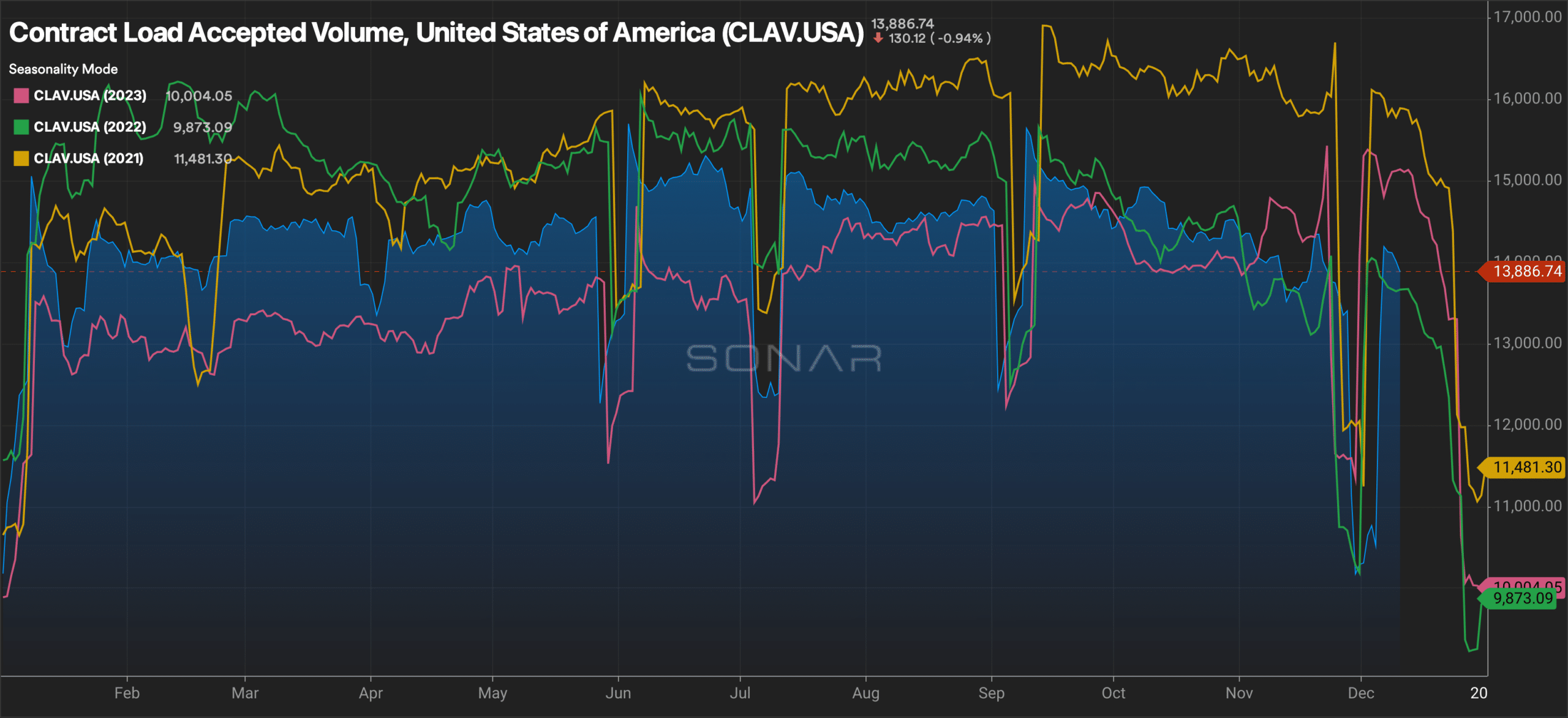
DAT reports that November spot loadings were down nearly 26% from October and 7.0% from November 2023. The large month-over-month decrease likely correlates with the spot posting surge following Hurricanes Helene and Milton in October. Notably, postings during the first week of December were up 116% from the last week of November. While this was largely due to fewer business days during Thanksgiving, it is still one of the largest week-over-week upticks we have seen.
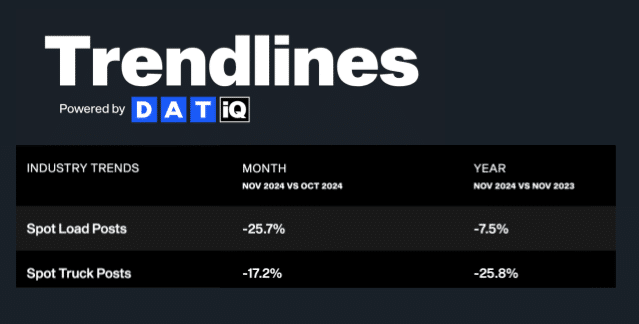
The Cass Freight Index’s shipments component is a good indicator of overall market health because it encompasses both spot and contract freight based on bill data. The November reading showed a slight month-over-month increase in shipments on a seasonally adjusted and non-seasonally adjusted basis. The Cass data deviating from DAT spot posting data indicates a pullback in spot activity as October disruptions subsided and the market returned to typical patterns in November.
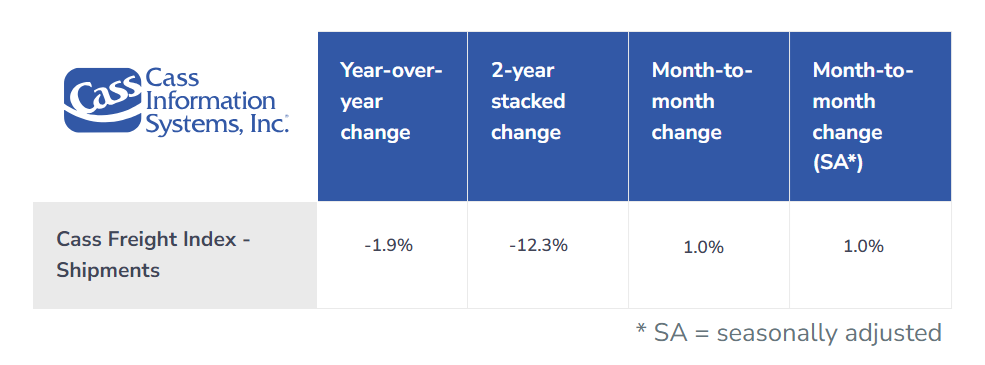
What’s Happening: Shippers are experiencing the most significant routing guide challenges in over two years.
Why It Matters: Despite those challenges, there is no indication of a sustained market shift.
Heading into the final weeks of the year, we are getting a glimpse of how the 2024 peak season compares to 2023. Right off the bat, it is clear shippers are experiencing more routing guide challenges than during any other seasonal demand exposure in more than two years. While these measures support the idea that we have moved past the bottom and supply and demand are more balanced than a year ago, the data is not yet pointing to a sustained disruption.
The Sonar Outbound Tender Reject Index (OTRI), which measures the rate at which carriers reject the freight they are contractually required to take, is trending well above where it was a year ago and fairly close to 2019 levels. Rejections during Thanksgiving this year were over 60% higher than last, and if a similar increase occurs around Christmas, levels could reach 10% for the first time since April 2022.
In the full history of the FreightWaves Sonar OTRI, the measure only rose above 10% when a market disruption was in progress or conditions were primed for one with the right catalyst. For example, in 2019, rejection rates peaked at roughly 14% over Christmas week. A few months later, pandemic-related buying patterns sent the market on a multi-year bull run. While that was an extraordinary black swan event and is unlikely to occur again in the next few months, it does highlight that OTRI volatility leading up to the 2020 disruption indicated market vulnerability.
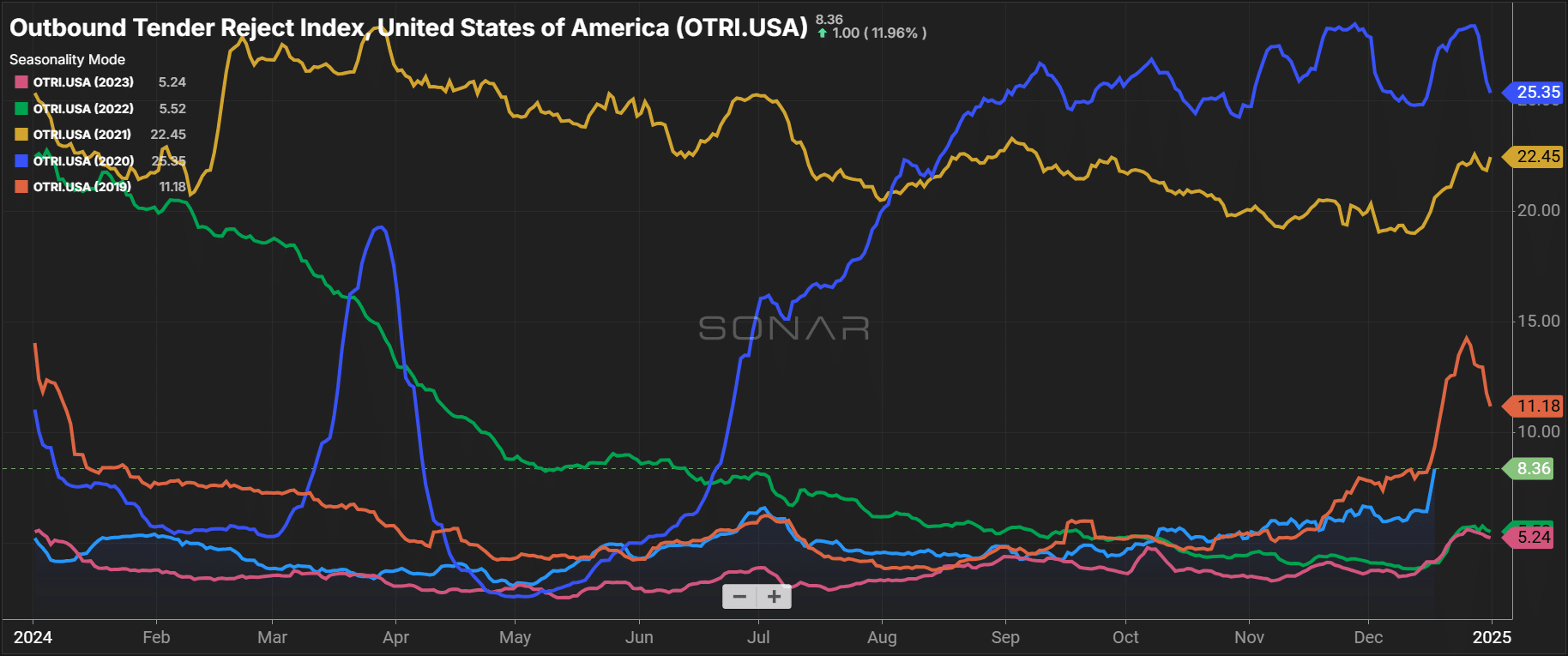
Dry van tender rejections remain well above 2023 levels and are spiking in line with typical seasonal expectations, indicating that the market continues to see more volatility than a year ago. With rejections already approaching 8% ahead of the holiday week, further increases will offer insight into just how sensitive the market is heading into 2025. During the second half of December 2023, we saw a sharp increase in tender rejections followed by a sharp reduction in mid to late January. We expect similar trends this year, but some risk remains with the looming threat of a mid-January port strike and the new administration taking office on January 20th.
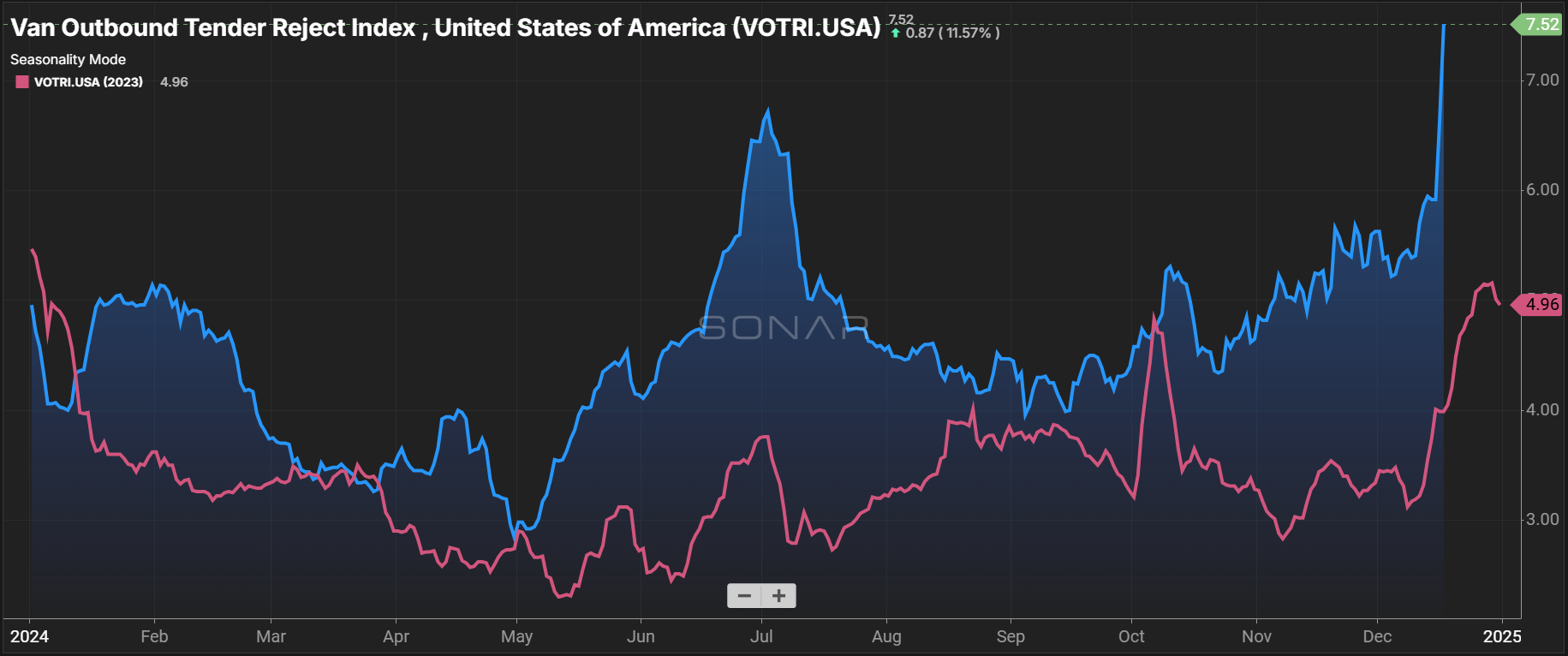
The reefer market continues to illustrate similar year-over-year trends to the van market, indicating improved supply and demand balance. However, with rejections on track to pass 20%, the same risks exist for reefer as for van. Throughout the history of the reefer-specific metric, the 20% range has been the threshold indicating an active or approaching disruption. That said, typical seasonality will likely be the narrative for the reefer market until the right catalyst occurs.
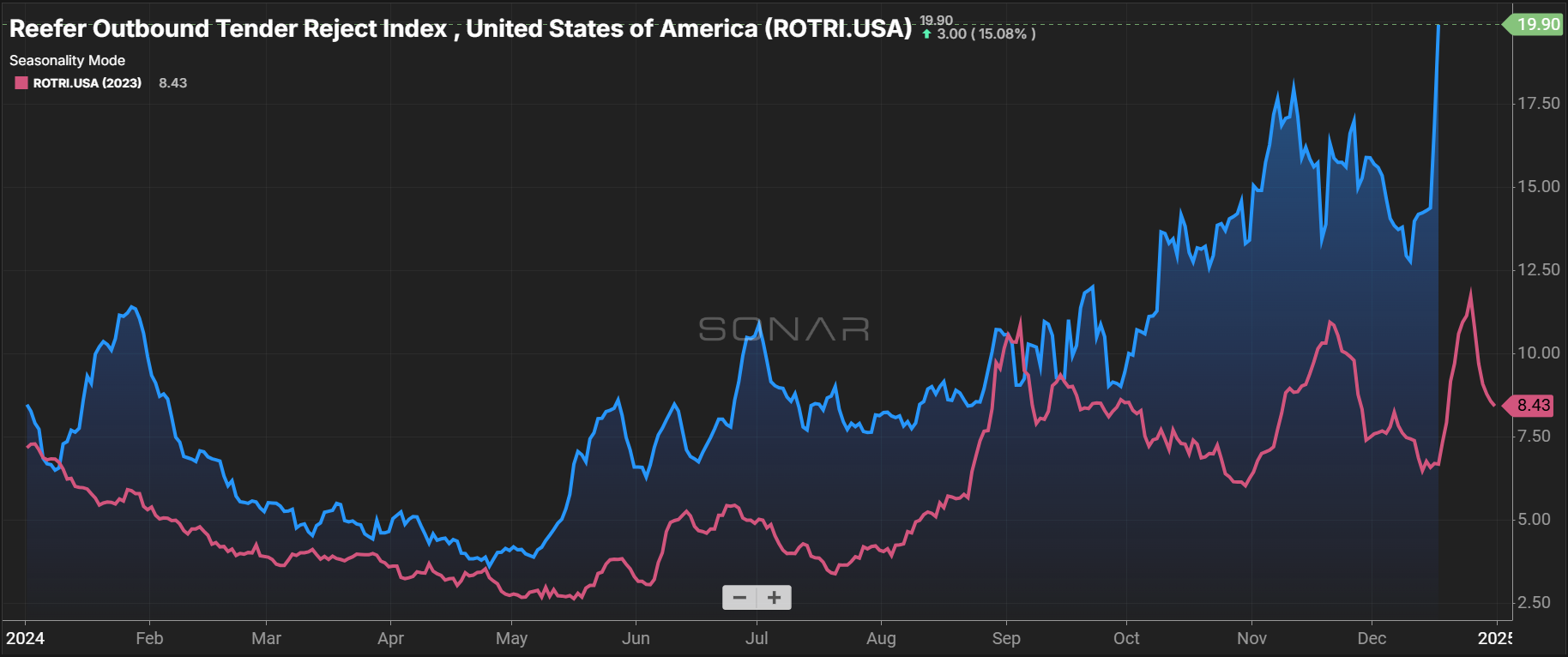
The DAT Load-to-Truck Ratio (L/T) measures the total number of loads relative to the total number of trucks posted on its spot board. The van L/T dropped slightly from October to November but is still above November 2022 and 2023 levels. The reefer L/T told a slightly different story, remaining essentially flat month-over-month and almost exactly in line with November 2022. Both indexes will likely see month-over-month increases in December.
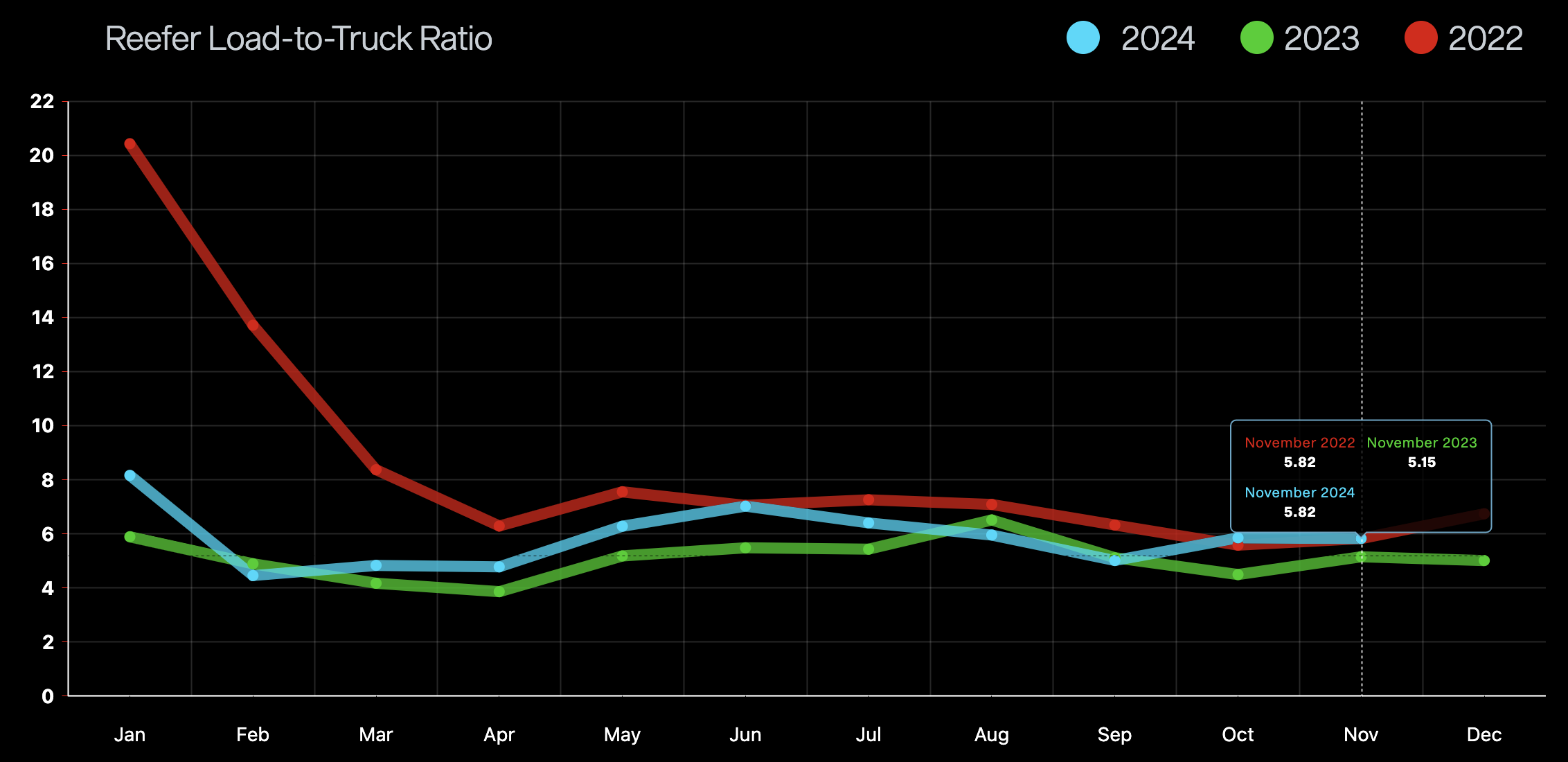
The Morgan Stanley Dry Van Freight Index is another measure of relative supply; the higher the index, the tighter the market conditions. The black line with triangle markers on the chart provides a great view of what directional trends would be in line with normal seasonality based on historical data dating back to 2007.
Despite recent routing guide disruptions and rate volatility, as of mid-December, the latest reading shows no meaningful activity or demand increases and trends returning to the 10-year average amid seasonal cooling
Morgan Stanley Dry Van Truckload Freight Index
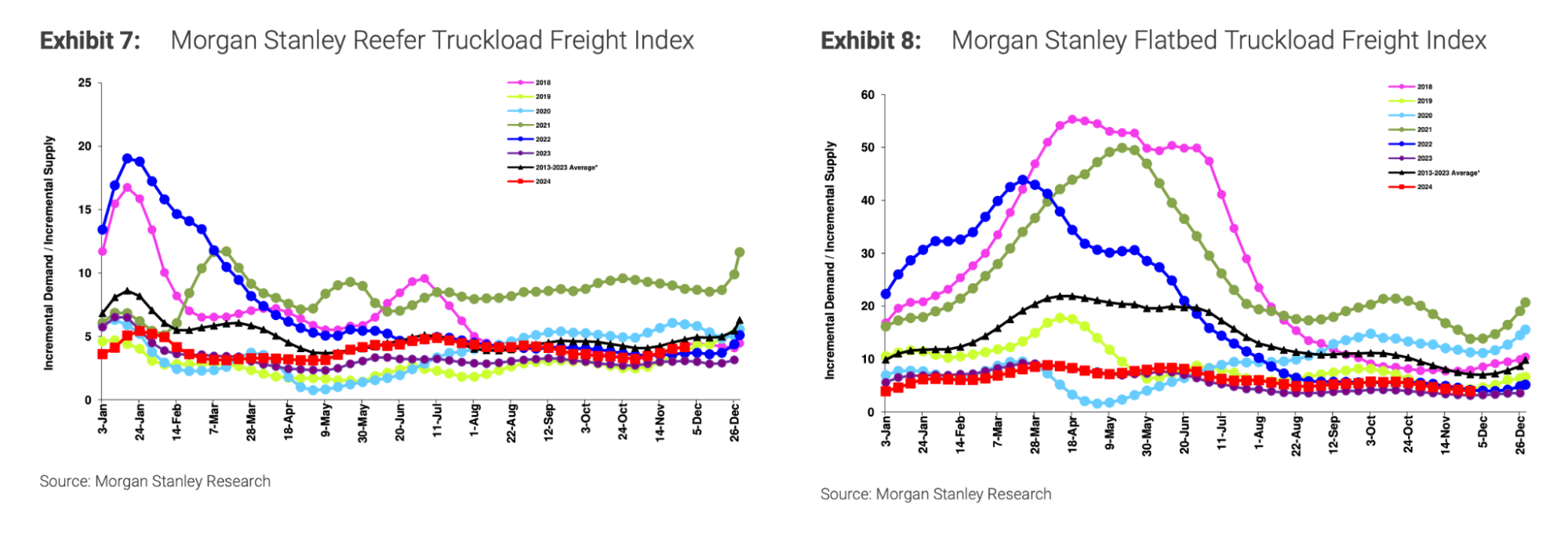
What’s Happening: Rates are rising as the holidays approach.
Why it Matters: This is normal seasonality, and we expect rates to settle in early Q1.
According to weekly spot market data provided by Truckstop, which we believe provides the best view of week-to-week seasonal volatility, rates are moving as expected throughout November and December. Typical seasonal patterns call for localized peaks around both holiday weeks, followed by a return to the floor in late January and early February. While risks related to external factors such as winter weather, a possible port strike and the new administration could complicate the exact timing, we still expect a rate pullback in early Q1.
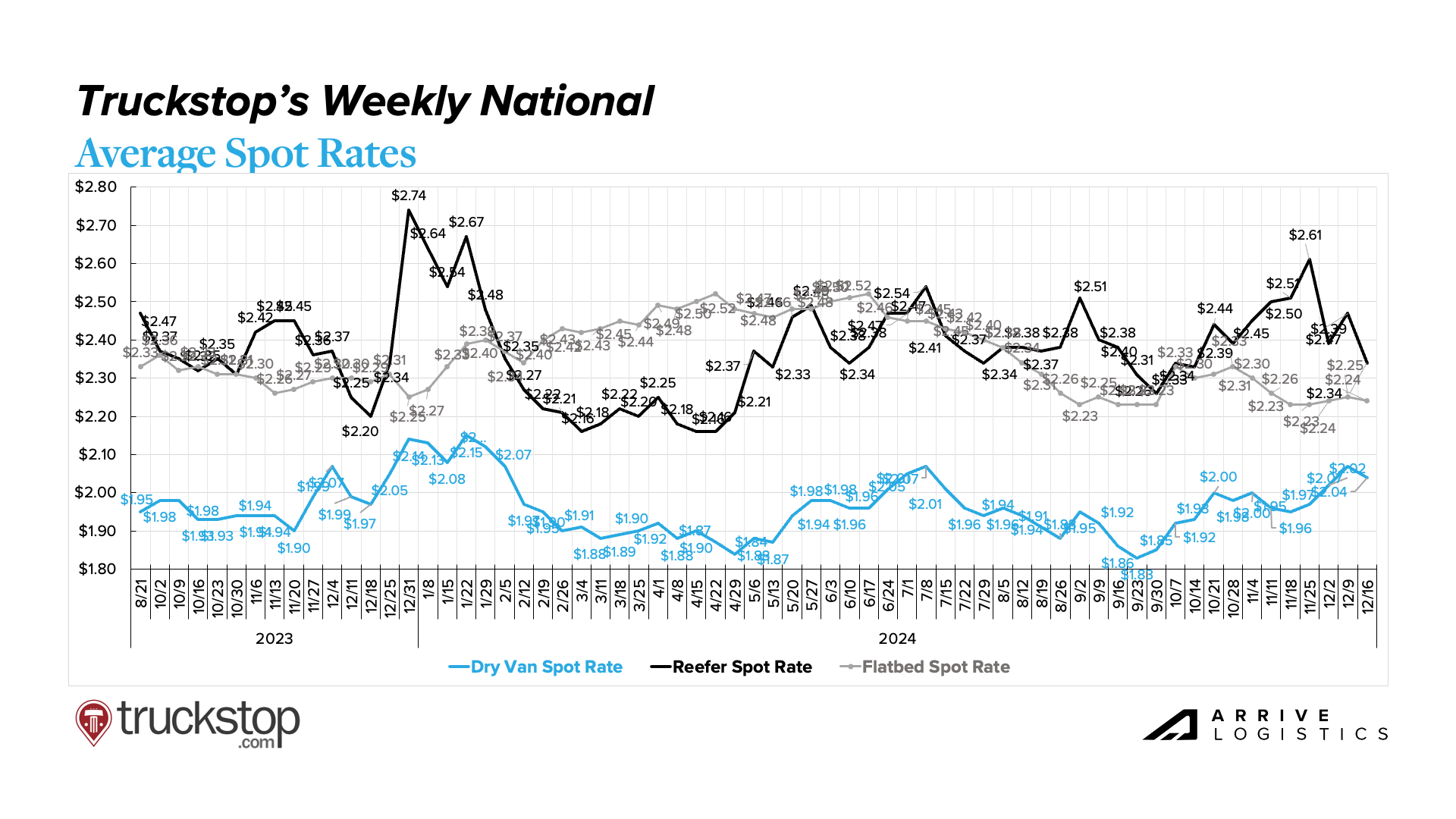
According to DAT, all-in dry van spot rates remained flat in November compared to October, and have slightly ticked up in early December. Reefer spot rates followed a slightly different trend, rising in November before declining slightly in early December. Reefer demand typically picks up in the back half of Q4, so this confirms a return to typical seasonal patterns.
It is important to note that fuel has consistently declined over this time period, indicating that true linehaul rates increased across both van and reefer in November. Additionally, flatbed rates remain relatively flat.
DAT Monthly Rate Trends
National diesel prices continue to tick down, with the November average sitting at $3.52 per gallon. Low fuel prices continue to benefit carriers navigating higher operating costs amid low revenues. The long-term fuel cost outlook remains favorable for carriers, as the EIA predicts that global oil production will rise by over 1.6 million barrels a day in 2025, including a projected increase of U.S. production from 13.2 million barrels a day to 13.5 million barrels a day. While it is impossible to predict future fuel prices, additional supply should help keep them lower.
DAT dry van data is starting to show the seasonal rate volatility we would expect this time of year. At $1.71 per mile, excluding fuel, spot rates are up nearly 4% year-over-year in December and still climbing, while contract rates have returned to flat year-over-year.
The rate gap remains large at $0.33 per mile, making any sustained disruption at this time unlikely. However, this is half the cycle high of $0.66 seen in November 2022, where spot linehaul rates were also $1.71 per mile, excluding fuel. As the gap closes further, the risk of normal seasonal patterns or other external catalysts creating sustained disruption to shipper routing guides increases.
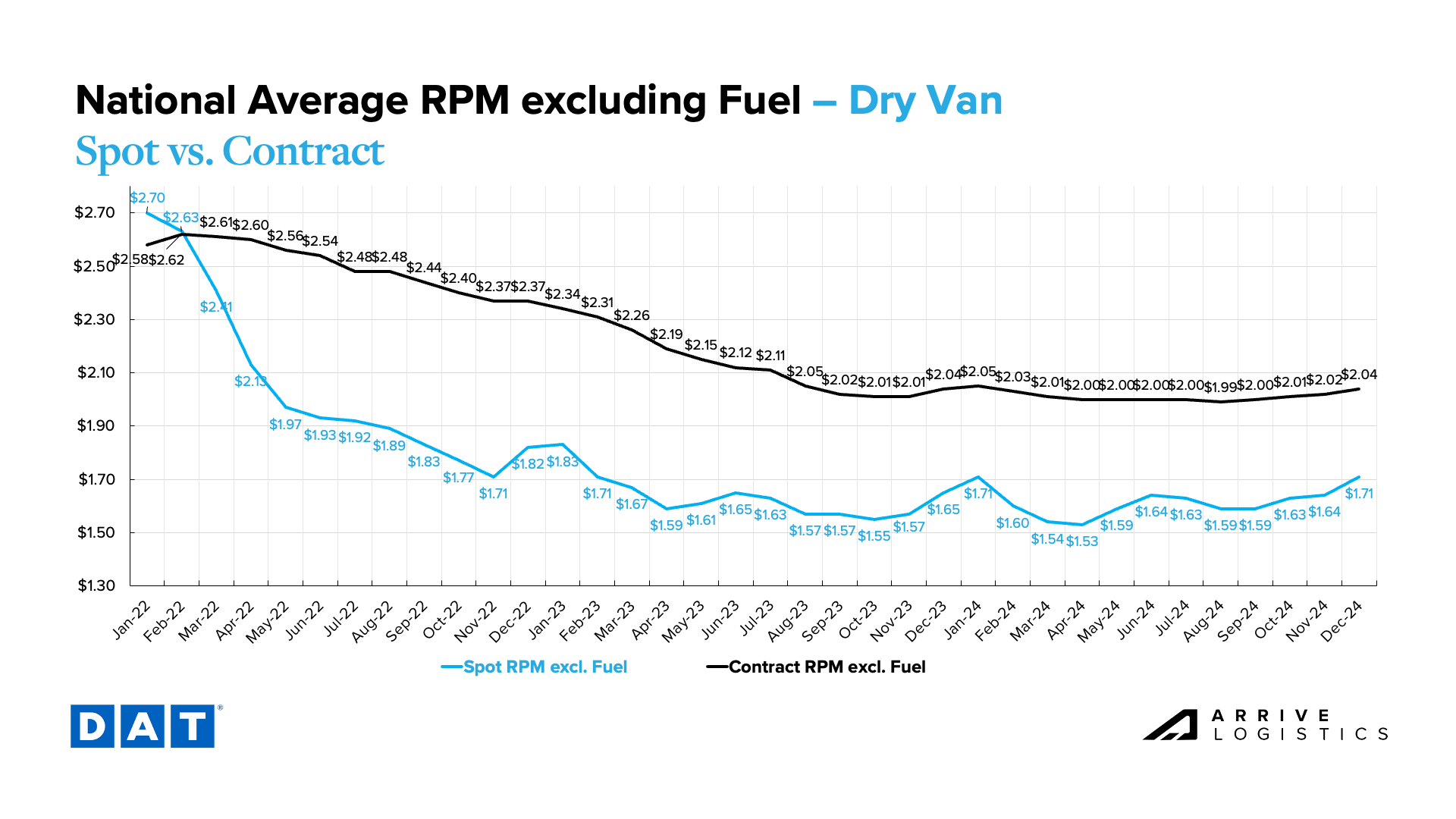
Reefer markets were volatile in November, with spot rates, excluding fuel, jumping up to $2.04 per mile from $1.97 per mile in October. Contract rates also increased slightly to $2.32 per mile but remain relatively stable overall.
Early December trends show a slight pullback in spot rates. However, as challenges increase around the holidays, we expect the end-of-month results to show tightening similar to the period around Thanksgiving.
The spot-contract rate gap is currently at $0.30 per mile, a slight increase from the cycle low of $0.28 per mile this November but down significantly from the cycle high of $0.58 per mile in October 2022, when spot linehaul rates were at $2.08 per mile, excluding fuel. As a result, the reefer market remains more susceptible to disruption than the dry van market.

Flatbed rates rose slightly in early December but remained relatively steady. Contract rates show a large uptick, but that is typical as tender rejections increase at this time of year. Ultimately, the flatbed market continues to follow a more stable pattern than dry van and reefer. The spot-contract rate gap remains historically elevated, with no major disruptions likely in the near term.
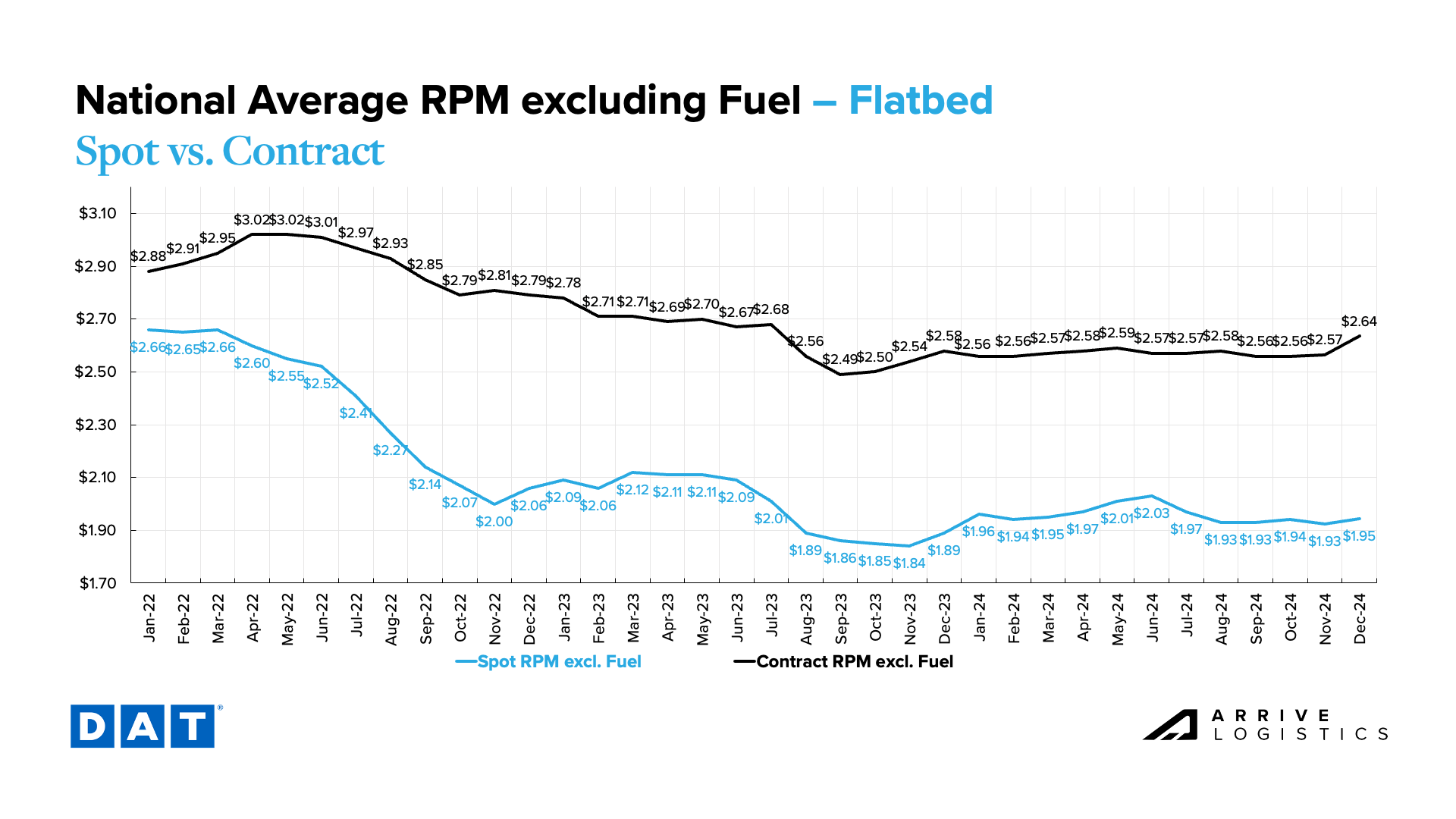
What’s Happening: Volatility is increasing ahead of the holidays.
Why It Matters: Any disruptions will likely subside in Q1 2025.
What’s Happening: Increased holiday volume is creating border bottlenecks.
Why It Matters: This should subside in Q1.
What’s Happening: Seasonality is driving regional tightness.
Why It Matters: Rates are rising in these areas.
East Coast
Midwest
South
West
Pacific Northwest (PNW)
What’s Happening: Carrier exits have slowed somewhat.
Why It Matters: This is likely due to increased seasonal opportunities, and we expect exits to ramp up again in 2025.
The flow of carriers out of the market continues, but the pace has slowed. FTR noted in its most recent report that over the past four months, the average decline in the for-hire population has been just 327 carriers per month, compared to 1,755 per month throughout 2023. While recent disruptions, holiday rate increases and fuel price declines may offer many carriers a sense of stability, we anticipate further capacity reductions in 2025.
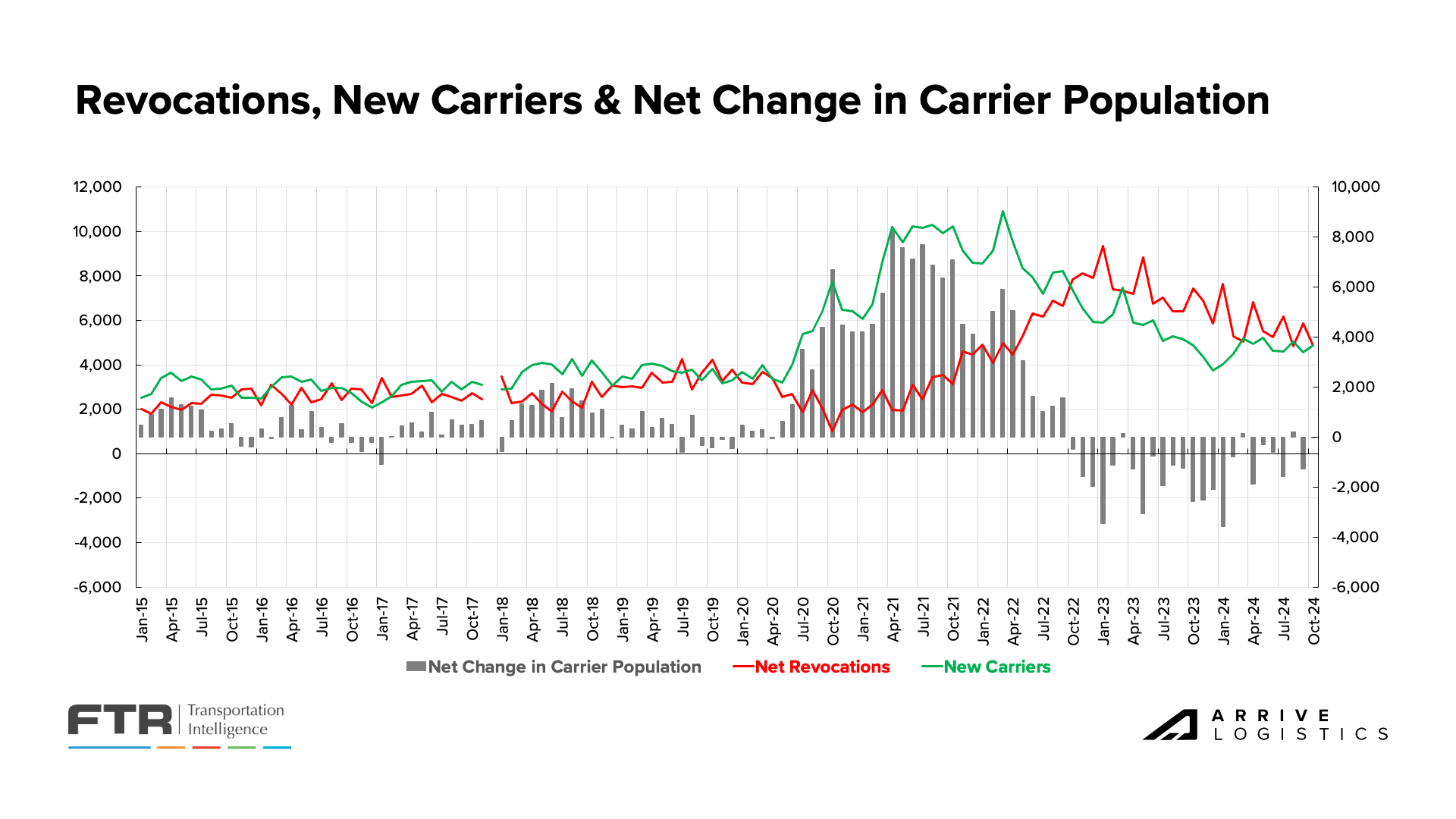
Driver availability remains relatively soft. There is little evidence of a shortage, likely due to older drivers staying on the road longer to cover their high cost of living, plus the growing migrant population. Driver availability is showing very slight tightening as a result of the recent drug and alcohol clearinghouse rule changes around drivers with prohibited status.
For Hire Driver Availability Index, ACT Research
The November trucking jobs report indicated an increase of just 2,900 jobs on a seasonally adjusted basis. Although total jobs are up 3,700 over the past four months, they were still down 1,400 year-over-year in November and more than 39,000 from the peak in July 2022. The long-haul sector continues to show job losses consistent with for-fire carrier data, a sign that optimism around recent green shoots isn’t necessarily driving an uptick in long-haul trucking employment.

FTR’s latest truck utilization forecast remains relatively unchanged. Current utilization is almost above the 10-year average of 92% and should continue to improve gradually through 2025 and into 2026. Equipment utilization improvement is a sign that fleet networks are tightening, and as that number approaches 100%, the risk of sustained disruption increases.

What’s Happening: A potential strike and possible tariff increases are creating uncertainty.
Why It Matters: The outcome could impact volume to the up or downside.
The key demand variables to watch are the potential port strike in mid-January and the tariff increases slated for late January. As outlined in our special notice this month, these events have the potential to create both upward and downward risks to volume. However, given the lingering uncertainty around both events, our outlook still calls for flat to slow demand growth in 2025.
The National Retail Federation estimates a 14.3% increase year-over-year in December, which would close the full year out 14.8% above 2023 levels. The elevated levels earlier in the year were expected due to the initial threat of a strike in October, but they have continued as shippers have looked to de-risk heading into a potential disruption in January.

Recent Descartes data shows that imports continue to decline month-over-month, which is in line with seasonal expectations for November. Overall, imports remain strong, with only November 2021 besting November 2024, which bodes well for demand heading into 2025.
While Q1 is typically a slower time for imports, a port strike would significantly increase the risk of supply chain disruptions. For the sixth straight month, West Coast ports handled more imports than East and Gulf Coast ports, possibly indicating that shippers are relying on the West Coast to avoid disruptions from a potential strike.
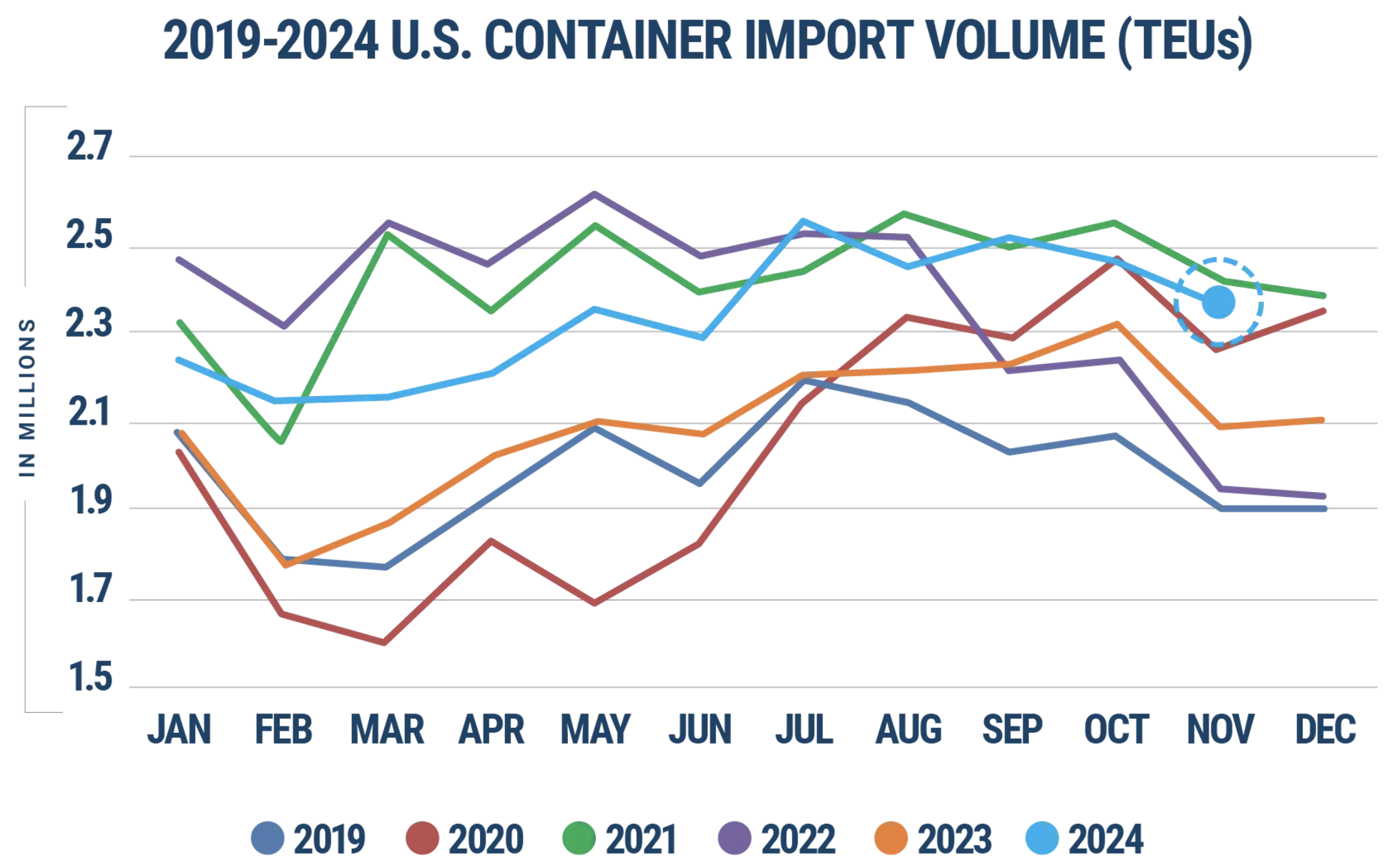

The manufacturing sector continues to contract, with the index sitting below 50 in 24 of the past 25 months, including the last eight. The most recent reading increased by 1.9 percentage points to 48.4. However, ISM notes that a reading above 42.5 indicates economic expansion, and November marked the 55th consecutive month with a reading above that threshold. As interest rates continue to decline and spending increases, manufacturing demand could grow and potentially drive the index above 50 in 2025.
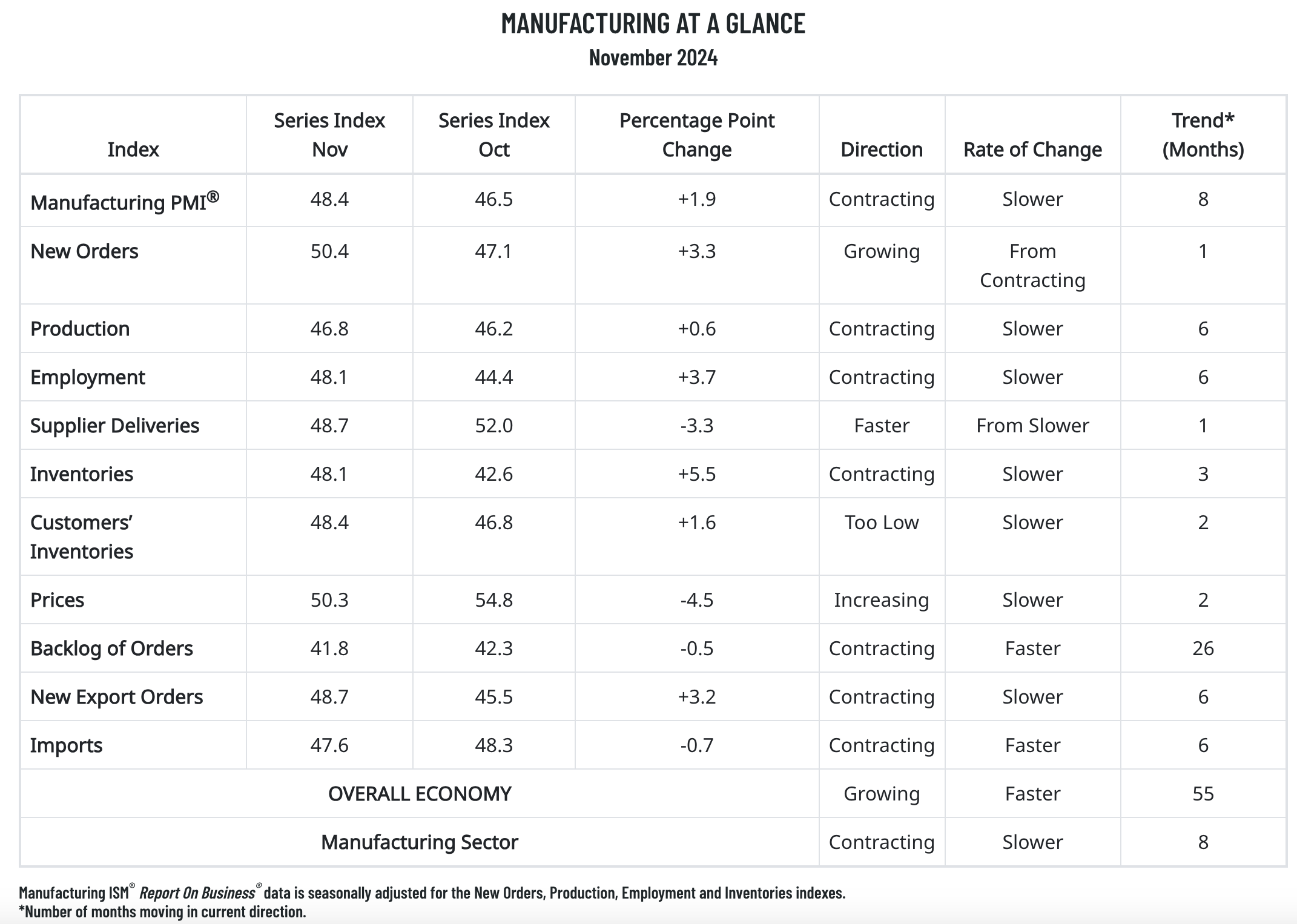
Economic trends in freight-related industries remain fluid. As industrial production and manufacturing declined, unemployment remained low, retail activity showed positive growth and mortgage rates fell for the second consecutive month. With interest rates dropping and the consumer market holding steady, the manufacturing and housing sectors could grow, providing a meaningful boost to overall freight demand in 2025.
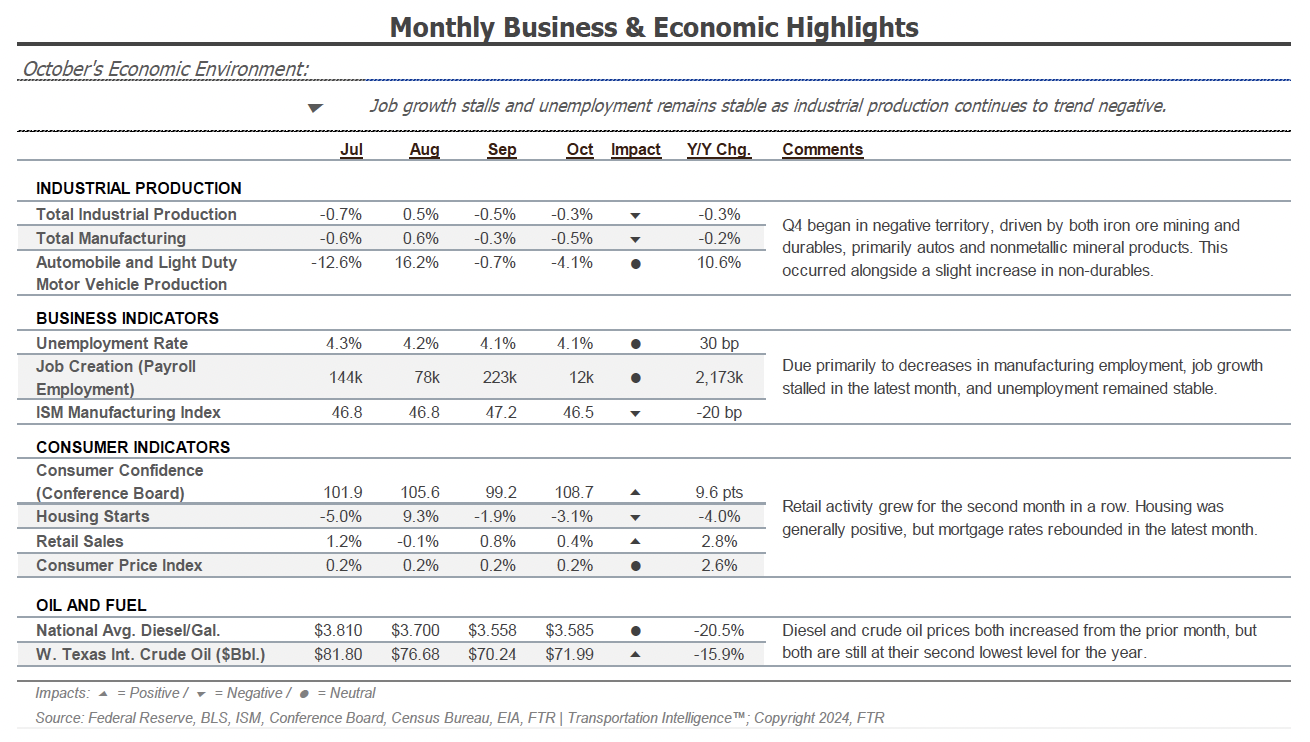
FTR made a slight downward revision to its 2024 truck loadings forecast, calling for total truckloads to grow 0.3% year-over-year, down from 0.4% last month. The dry van loadings forecast now predicts 1.5% growth in 2024 and 1.7% in 2025. The reefer outlook remains strong for both 2024 and 2025, calling for 2.2% and 3.4%, respectively.
Overall, the 2025 outlook is still strong, with truck loadings seeing a positive revision of 10 basis points, indicating projected growth of 1.7%.
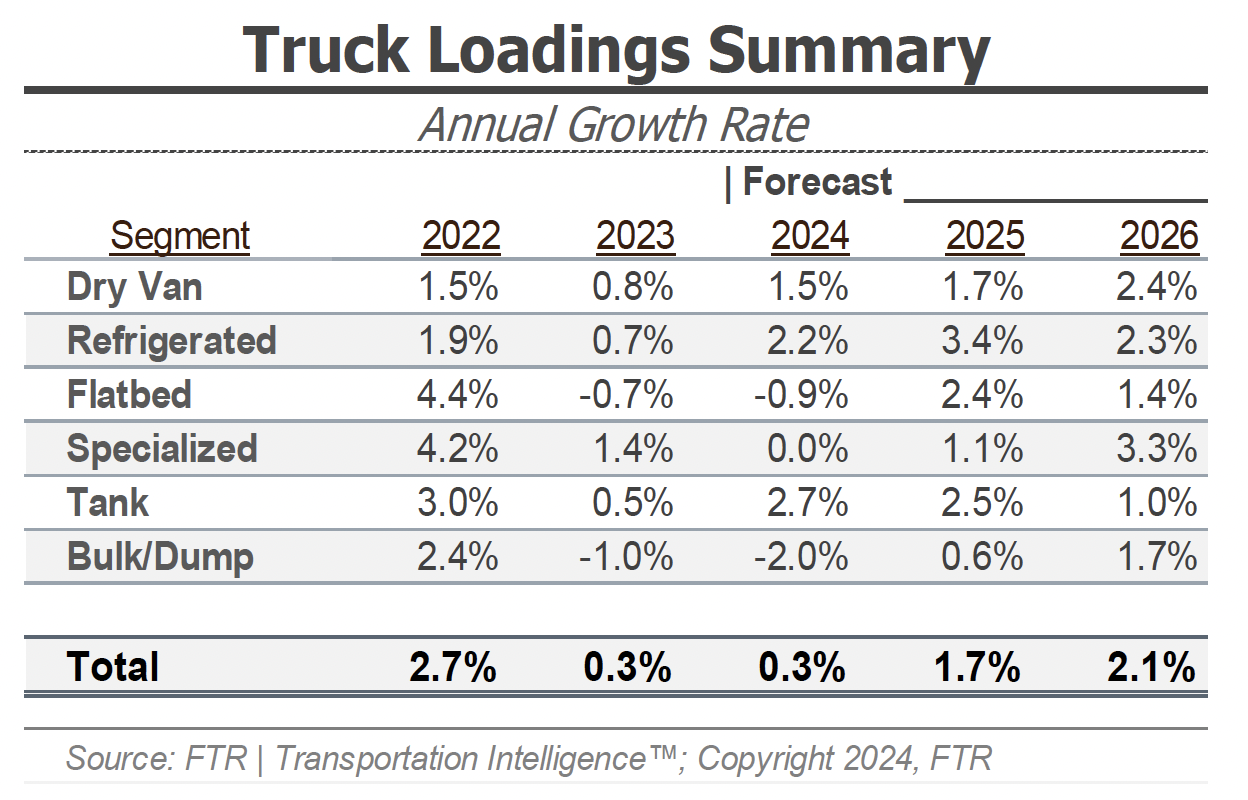
What’s Happening: Inflation ticked up in November.
Why It Matters: The Fed may pause rate cuts planned for early next year.
Inflation remains above the target rate and ticked up to 2.7% in November. The Fed made another quarter percent cut during its December meeting and will revisit additional rate cut plans in January. With inflation remaining sticky, the Fed may pause rate cuts at the beginning of next year. In any case, no meaningful implications of rate cuts will materialize in the freight market until late next year.

Recent Bank of America credit card data shows that consumers remain resilient. There were no signs of weakness in November or over the first few weeks of the holiday shopping season, and spending levels should stay relatively stable in the near term as long as the labor market and wages continue to display strength.

The 4.2% unemployment rate and relatively flat total non-farm payroll employment indicate a strong labor market. This trend encourages steady consumer spending, which in turn supports stable demand.

We expect typical seasonality to remain the narrative through this peak season and into Q1 2025. Elevated tender rejection rates and increased spot activity through recent disruptions are signs the market is more balanced than a year ago, and we are closely watching holiday season trends to better understand just how sensitive conditions are to sustained disruption in 2025. There has already been more rate volatility than last year, but strong supply conditions should support swift normalization following any further fluctuations.
Demand stability seems likely, especially as shippers pull forward imports amid concerns about a second port strike and potential tariff increases. However, we believe supply is still sufficient to keep routing guides intact beyond peak season. As the new administration’s plans become clearer, so will their impact on transportation markets. A few focus areas we’re monitoring are tariffs, immigration, labor, industry regulation and environmental policy.
With the right catalysts, a market flip is not out of the question. However, we are not yet ready to call for widespread disruption in the near term until the data shows more signs of vulnerability or a black swan event that could shock demand or supply appears imminent.
The Arrive Monthly Market Update, created by Arrive InsightsTM, is a report that analyzes data from multiple sources, including but not limited to FreightWaves SONAR, DAT, FTR Transportation Intelligence, ACT Research, Morgan Stanley Research, Bank of America Internal Data, Journal of Commerce, Stephens Research, National Retail Federation and FRED Economic Data from the past month as well as year-over-year. We understand market data is vital in making real-time business decisions. At Arrive Logistics, we are committed to giving you the data and insights you need to better manage your freight.

